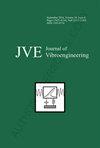Gabor小波变换与区域CNN相结合在斜拉索外观智能检测中的应用
IF 0.9
Q4 ENGINEERING, MECHANICAL
引用次数: 0
摘要
斜拉桥中传递力的主要结构是斜拉索。如果斜拉索系统发生故障,整座桥就会倒塌。目前,对桥梁电缆的检测还没有非常成熟的技术手段。最常见的方法是工人定期手动检查和更换电缆。虽然可以在一定程度上检测电缆的缺陷状况,但无法实现对其健康状况的实时监测。因此,本研究采用中值滤波器、均值标准化方法和Retinex算法对图像数据进行预处理。在利用Gabor小波变换提取斜拉索图像的宏观特征后,利用OTSU方法实现了图像分割。将获得的特征图像应用于快速区域卷积神经网络(RCNN)识别模型,以检测微观缺陷。在研究过程中,传统卷积神经网络(CNN)的训练效率并不高。因此,Faster RCNN建立了一个电缆缺陷识别模型。在此基础上,建立了基于Gabor小波变换和改进的RCNN的斜拉索外观缺陷智能检测模型。通过实验分析,为研究建立的模型识别准确率为94.14%,可以实现桥梁健康动态监测,即时识别斜拉索的状况,维护桥梁的安全。本文章由计算机程序翻译,如有差异,请以英文原文为准。
Gabor wavelet transform combined with area CNN in appearance intelligent detection of stayed cables
The major structure for transmitting forces in a cable-stayed bridge is the stay cable. If the stay cable system fails, the whole bridge will collapse. At present, there is no very mature technical means for the detection of bridge cables. The most common method is for workers to perform regular manual inspection and replacement of cables. Although the defect condition of the cable can be detected to a certain extent, the real-time monitoring of its health cannot be realized. Therefore, the research used the median filter, mean standardization method and Retinex algorithm to preprocess the image data. And after extracting the stay cable picture’s macroscopic characteristics using the Gabor wavelet transform, it implemented image segmentation using the OTSU approach. The obtained feature images were applied to the Faster Regional Convolution Neural Network (RCNN) recognition model to detect microscopic defects. During the research, the training efficiency of traditional Convolution Neural Network (CNN) was not high. Therefore, Faster RCNN built a cable defect recognition model. Based on this, the research built an intelligent detection model for apparent defects of stay cables based on Gabor wavelet transform and improved RCNN. Through the experimental analysis, the model built for the study has a recognition accuracy rate of 94.14 %, which can achieve dynamic bridge health monitoring and instantly identify the condition of the stay cables, and maintain the safety of the bridge.
求助全文
通过发布文献求助,成功后即可免费获取论文全文。
去求助
来源期刊

Journal of Vibroengineering
工程技术-工程:机械
CiteScore
1.70
自引率
0.00%
发文量
97
审稿时长
4.5 months
期刊介绍:
Journal of VIBROENGINEERING (JVE) ISSN 1392-8716 is a prestigious peer reviewed International Journal specializing in theoretical and practical aspects of Vibration Engineering. It is indexed in ESCI and other major databases. Published every 1.5 months (8 times yearly), the journal attracts attention from the International Engineering Community.
 求助内容:
求助内容: 应助结果提醒方式:
应助结果提醒方式:


